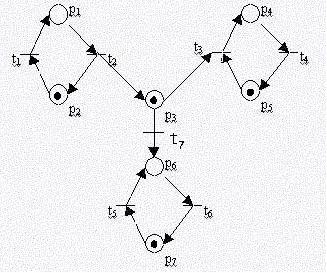

Petri-Net and Augmented-Petri-Net
If a transition has several output places, each place will obtain a
token when that transition fires. This can be used to model
concurrent processes.
On the other hand, if a transition has several input places, it is
enabled only when each place gets a token. This can be used to
model synchronization of concurrent processes.
If a place has several output transitions, these transitions will
contend for the token at that place, when they are fired.
In which case, these transitions are said to be
in conflict.
This can be used to model asynchronous decision-making processes
which may interfere with one another.
The distribution of tokens in a marked Petri-net defines the state of the net and
is called its
marking.
The marking may change as a result of the firing of transitions.
In different markings, different transitions may be enabled.
For example, in the marked net of Figure 3, three transitions,
t1, t3, and t5, are enabled. In this situation, we have a choice
as to which transition will fire next.

Figure 3. The marking resulting from firing transition t2 in
Figure 2. Note that the token in p1 was removed and tokens
were added to p2 and p3.
Although Petri-nets are basically very simple, they can be utilized
in many different ways. They are a major model for concurrent systems.



